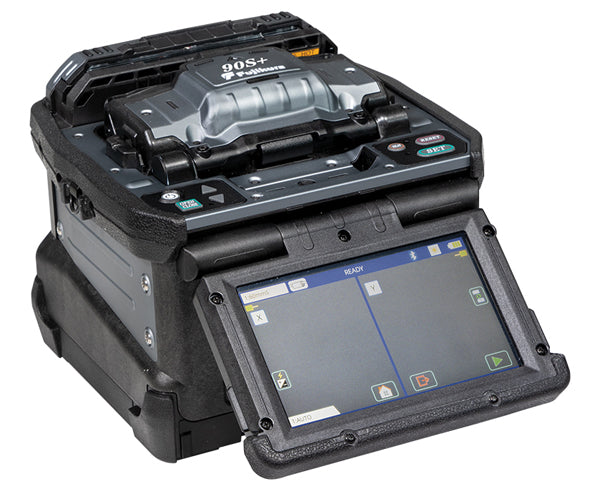Description
Description
Fujikura 90S+ Core Alignment Fusion Splicer
The Fujikura 90S+ Core Alignment Fusion Splicer solves common problems seen in the field. Everything from splicing poor quality legacy fibre to automated equipment maintenance and upkeep. The Fujikura 90S+ can be used in multiple field splicing applications including bend-insensitive fiber in drop cables, long-haul terrestrial and submarine LEAF® fibers, loose buffer fiber, splice-on connectors, and the list goes on.
The speed and accuracy of the 90S+ make it suitable for certain production and specialty environments where high output, tight packaging, and low loss requirements are required.
Regardless of your scenario, the Fujikura 90S+ is designed to keep you in the field with an extended battery life of 300 splice and heat cycles. With its multiple automated and easy-to-use features, the 90S+ alleviates the need for traditional operation tasks such as frequent arc calibrations, cleaver blade rotations, cleaver usage tracking, and manual splicing operations.
A redesigned work tray, cooling tray, and optional cable clamp make the 90S+ kit more versatile than its predecessors in adapting to varying work conditions and environments. When splicing loose buffer fibre, additional sheath clamps are not needed. The standard universal sheath clamp now handles both loose and tight buffer fiber.
The new Active Fusion Control (AFC) technology improves splice losses for fiber with a poor cleave angle. Combined with Active Blade Management between the splicer and cleaver, the Fujikura 90S+ contains a robust set of splicing features that will reduce the likelihood of poor splice installations or repairs.
Features
Features
- Cleaver tracking and upkeep with wireless communication
- Improved real-time arc control for fibers with poor cleave angles
- Loose and tight buffer with same sheath clamp
- Automated wind protector, sheath clamps and splice operation
- Graphical User Interface with 5.0" touchscreen PC software and 90S manual downloaded from splicer
- Multi-function transit case with integrated workstation
- Lithium-ion battery with 300 splices/shrinks per charge
Specifications
Specifications
Additional Information
Additional Information
Fusion Splicing Process
The process of fusion splicing normally involves using localized heat to melt or fuse the ends of two optical fibers together. The splicing process begins by preparing each fiber end for fusion.
Stripping the Fiber
Stripping is the act of removing the protective polymer coating around optical fiber in preparation for fusion splicing. The splicing process begins by preparing both fiber ends for fusion, which requires that all protective coating is removed or stripped from the ends of each fiber. Fiber optical stripping can be carried out by a special thermal fiber stripper tool that uses hot sulphuric acid or a controlled flow of hot air to remove the coating. There are also mechanical fiber strippers used for stripping fiber which are similar to copper wire strippers. Fiber optical stripping and preparation equipment used in fusion splicing is commercially available through a small number of specialized companies, which usually also designs machines used for fiber optical re-coating.
Cleaning the Fiber
The bare fibers are cleaned using alcohol and wipes.
Cleaving the Fiber
A fiber cleaver is then used to cleave the fiber using the score-and-break method so that its end-face is perfectly flat and perpendicular to the axis of the fiber. The quality of each fiber end is inspected using a microscope. In fusion splicing, splice loss is a direct function of the angles and quality of the two fiber-end faces. The closer to 90 degrees the cleave angle is the lower optical loss the splice will yield.
Splicing the Fibers
Current fusion splicers are either core or cladding alignment. Using one of these methods the two cleaved fibers are automatically aligned by the fusion splicer in the x,y,z plane, then are fused together. Prior to removing the spliced fiber from the fusion splicer, a proof-test performed to ensure that the splice is strong enough to survive handling, packaging and extended use. The bare fiber area is protected either by re-coating or with a splice protector. A splice protector is a heat shrinkable tube with a strength membrane.
What's In The Box
What's In The Box
- Qty 1 - Fujikura 90S+ Fusion Splicer
- Qty 1 - ADC-20 AC Adapter
- Qty 1 - ACC-14 AC Cord
- Qty 1 - BTR-15 Battery
- Qty 1 - ELCT2-16B Spare Electrodes (Pair)
- Qty 1 - Sheath Clamps
- Qty 1 - SP-03 Fiber Holder Set Plates
- Qty 1 - USB-01 Cable
- Qty 1 - Alcohol Dispenser
- Qty 1 - Screwdriver
- Qty 1 - Splicer Carrying Strap
- Qty 1 - Quick Reference Guide
- Qty 1 - TS-03 Tripod Screw
- Qty 1 - Work Tray J-Plate
- Qty 1 - SS03 Single Fiber Stripper
- Qty 1 - CC39 Transit Case with Carrying Strap


